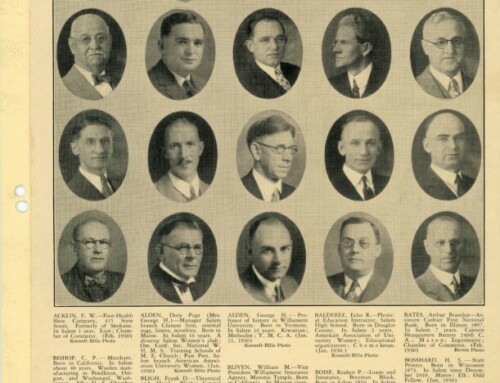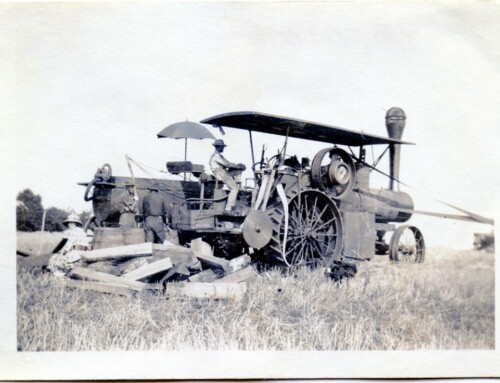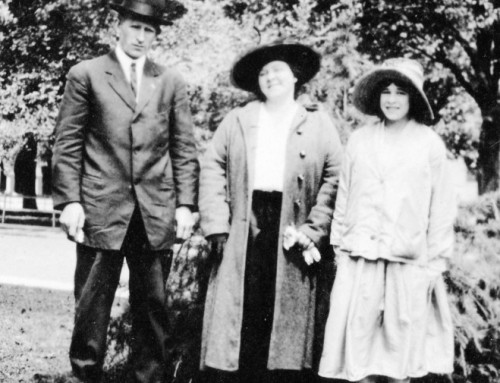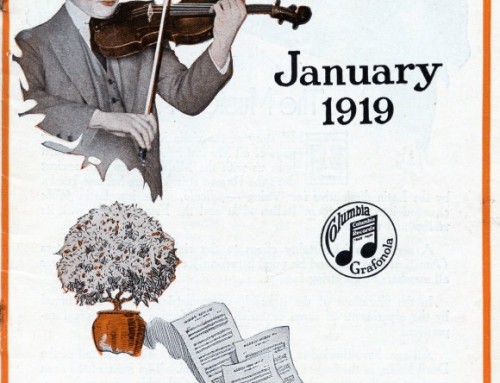We were pleasantly surprised recently when one of our research volunteers located an historic Oregon Journal article that provided history and context to this framed photo of the members of Tiger Engine Company, No. 2 in our collection. What follows is a transcribed account of the article found on page seven of the January 19, 1913 issue, accessed via Newsbank.
Keen Rivalry Existed Between the Volunteer Fire Fighters of Salem in the Days When the “Capitals” and the “Tigers” Strove for the Foxtail
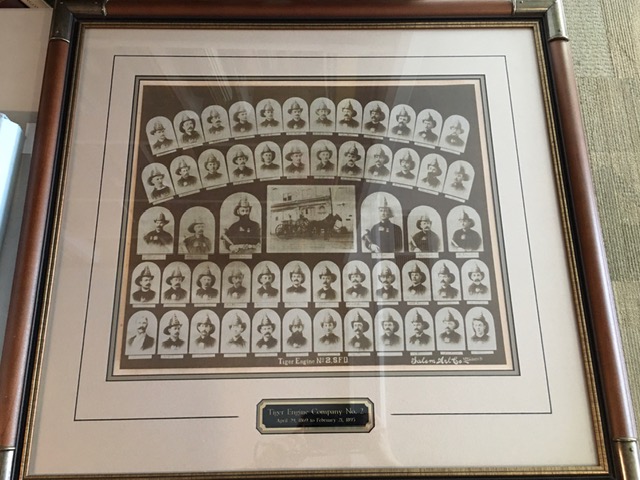
Portraits of members of Tiger Engine Co. No. 2, Salem Fire Department, WHC Collections 2019.020.0003
Caption: Members of Tiger Engine company, No. 2, Salem Fire Department, which was a formidable organization in days gone. The firemen in the picture are: Top row, left to right – W.D. King, John Darr, W.A. Benson, Bert F. Savage, W.H. Daney, C.G. Boothby, W.F. Smith, Jap [Harry] Minto, E.M. Croisan, J.K. Mount, B.E. Critchlow, E. Eckerly. Second row, left to right – John W. Veatch, W.M. Renne, Carroll Moores, E. E. Nichols, R.S. Waller, Murray Gilbert, L. Bash, J.S. Phillips, A.W. Veatch, F.E. Holman, Thomas Holman, C.O. Vaughn. Center row, left to right – F.R. Cross, second assistant foreman; Arthur Glover, first assistant foreman; E.C. Cross, foreman; Tiger company’s engine with driver, W.S. Low, chief: Stub Smith, pipeman; J.C. Luhrman, pipeman. Fourth row, left to right – R.J. Hendricks, R.H. Westacott, P.G. Nordron, George Hastings, engineer; Andrew Coss, Mark Savage, secretary; E.J. Rice, president; John H. Duncan, engine driver; J.J. Maurier, Al E. Simmons, C.D. Hutton, H.E. Basey. Bottom row, left to right – C.A. Walter, M. Minto, C.N. Northcut, E.H. Pugh, A.E. Strang, James H. Colbath, William Holcomb Jr., Ben Taylor, E.J. White, C.N. Lake, John Knight and R.Lee Steiner.
By P.H. McEnery
Salem, Or. Jan. 18 – During the seventies and eighties in Salem one of the proudest distinctions a man could have was to be ‘one of the foxtails.’ There were two volunteer bands of firemen in the capital city in those days and they were fiery rivals. There prevailed a perennial contest for supremacy. The guerdon was awarded after each fire. It was a foxtail. It was immediately hoisted on the engine of the winning company. The test of supremacy was in being the first to get to the hydrant or the first to get the water on the blaze. Before these two companies came into existence there was a small and ineffective fire department which was formed as far back as Dec. 4, 1857 when Salem was a village.
A few fires in close succession in the early sixties impelled the men of the town to form the Capital Engine No. 1 company. Sam Bass was the first chief. A mediocre hand engine was brought from Portland. It was called the ‘Squirred Tail.’ Judge Burnett, now of the Supreme Court was a chief or foreman of a fire company in early days, so also was J.G. Wright now steward of the State Insane Hospital. Prior to becoming a member of the highest tribunal in the state, Judge Burnett fought two or three blazes which threatened to destroy the city. The larges conflagration of this time was that which wiped out the Griswell-Hoyt sawmill, the damage totaling $100,000. Other big fires of that time were the Marion Hotel blaze and the Commercial street fire wherein Mr. Wright suffered the loss of his store.
The Tigers No. 2 Organized
The Tigers No. 2, with which this article is chiefly concerned, was formed on May 20, 1867. The latter was partly the outgrowth of the insistent need of better fire protection and also somewhat the result of some internal troubles in No. 1. Soon through capable organization and generalship it became a formidable rival. The rivalry was good for the town, then a community of about 2000 people. The citizens, with tactful impartiality, encouraged the unique competition. The members of each company in their devotion and pride to their respective companies were almost fanatical, their eager loyalty was well nigh a religion. The rushes following a fire alarm was a wild stampede and the attendant incidents formed prolific topics for household gossip for weeks or until the next blaze occurred and lent new matter for contention among the protegees of either faction. The ‘religion’ inspired in the struggle for the ‘much-coveted fox-tail’ soon developed into an obsession. Some fires were ‘touched off.’ They were not strictly speaking of an incendiary nature for neither malice toward property owners nor criminality of any kind impelled the acts, but the insane ambition to be in a position to get to the fire first was responsible.
On one occasion so conclusive was the evidence and so absolutely wanton the act that only the most influential intercession averted indictments against certain firemen. One of these incidents, too, was tinged with somewhat of troubadour-like romance. The mainspring of course was the inevitable female. Two suitors equally favored in her graces were necessarily the principals in the plot. Each was a fireman but in a rival company. The lady’s hand and heart was to be bestowed on the member of the company which should capture the ‘pennant’ the greater number of times during the current month. It was a trying ordeal for fires did not come often enough and the suspense of the wooers, especially the one who for the time being had the handicap adverse to his chances was most embarrassing. As the month drew to the close of the calendar one aspirant and his followers deliberately ignited a building so located as to be more contiguous to his company’s engine and favorable in every respect for gaining first access to the water main. As some of the participants have not yet passed into that stage where immortality may claim them the sequel will have to remain unfolded so far as this narrative goes.
“Tigers” Outwit Their Rivals.
All kinds of pranks were played by firemen on their rivals. One in which the principals are prominent citizens in Salem is worth mentioning. A fire alarm was turned in from what is now the center of the business district of the city. The Capitals were leading in the rush for the hydrant. One of the Tigers coming to join his associates and perceiving that his company was not in the lead successfully tried a ruse to supplant the leaders. ‘Here’s a hydrant’ he shouted to the Capital men, and he pointed to what was a stump of a maple tree. The decoy worked, the Capital men commenced to adjust their hose to the stump and the Tigers got first to the real hydrant and captured the foxtail. There is another such incident concerning a fire in Piety Hill which left some bad blood among the fire fighters.
The picture here shown of Company 2, the Tigers, was taken in the late eighties when rivalry among the two forces was at its zenith. This aggregation at the time had reached an almost invincible position. They had bedecked themselves with the foxtail time and time again. Desperate efforts were made by the No. 1s to wrest it from them, but unavailingly. It was a source of pardonable pride to be a Tiger in Salem in those days. Not only was every form of quickness of action and alertness demanded in each emprise but physical skill and dexterity in using fists were eminently desiderata in the case of candidates for admission. Many a helter-skelter running or pitched battle was fought along the streets in the dash for the hydrant and frequently there was copious blood on and around the hydrant before the water was untapped.
The Tigers during a goodly portion of their life had their headquarters in a wooden building in the rear of Oscar Johnson’s clothing store. The biggest fire they had to handle was that of Reed’s opera house. The blaze was handled successfully, the building was not a total wreck nor anything near that, though in its earlier stages it threatened to devastate the business section of the city. Drills were held regularly and the keenest zest was always maintained. Necessarily so for every fire was an accredited competition lost. The equipment was primitive and meager. For the Tigers it consisted of a hand engine also brought from Portland. The pumps were operated through the long rod which ran along either side of the engine. Later a Selsby rotary steam engine was secured and it was drawn by horse, not by men as heretofore.
Advantages of Fire Fighting.
About fifteen years ago the rival organizations for all practical purposes disbanded. There, then, came into existence the nucleus of the present efficient fire department. But the companies were not wiped out of official existence. By a state enactment volunteer firemen were entitled on the termination of seven years’ active association with a company to what was called an ‘exempt’ certificate awarded by the Board of Fire delegates. This exempted forever the holder from road tax, poll tax, and jury duty. At the time of the formation of the city fire department there were still in the ranks of the volunteer companies men who had served efficiently but had not yet completed their seven years’ service. The company was kept in existence till this term for these particular members was attained and then disbanded. These immunities had, needless to say, considerable effect in promoting the esprit de corps of the fire fighting forces and it has throughout the state proved a fruitful utile dulci.
Of the 51 men shown in the accompanying picture about 30 of them still reside in Salem and are all prominent and worthy citizens. At this period Walter S. Low, now a real estate man, was chief; Ed Cross, a local butcher, was foreman; A. Glover was first assistant foreman and F.R. Cross, now deceased, was second assistant. The present chief of Salem fire department, Mark Savage, was a Tiger. Many of the members of the famous organization occupy positions of municipal or state responsibility today. E.J. Rice was the last county assessor of Marion county; Dr. R.E. Lee Steiner is the superintendent of the State Hospital for the Insane; A.E. Strang, once foreman of the Tigers is chief engineer of the same institution and is fire foreman still as he is chief of the Asylum fire department; W.H. Hancy is manager of the Telephone company; E.M. Croisan is a prominent real estate man; J.K. Mount is in business in Silverton; Eugene Eckerlin is likewise successful in business; Carroll Moores is a state employee; Murray Gilbert a sign painter; Thomas Holman a capitalist, Arthur Glover and Ed Pugh are blacksmiths; Stub Smith a carpenter; R.J. Hendricks is publisher and editor of the Salem Daily Statesman; E.N. Westcott has a livery stable; John J. Maurer has a garage; A.J. Bacy is a capitalist; Harry Minto is the outgoing sheriff of Marion county; Ben Taylor is a post office employee; E.C. White is a guard at the State Penitentiary; and John Knight is Bailiff of the United States court at Portland.
Though their lives have run the gamut of many events and have been fraught with many responsibilities all will frankly concede that none stirred so deeply to high and eager endeavor as the keen pursuit of the Salem firemen’s prize – the lure of the foxtail.




